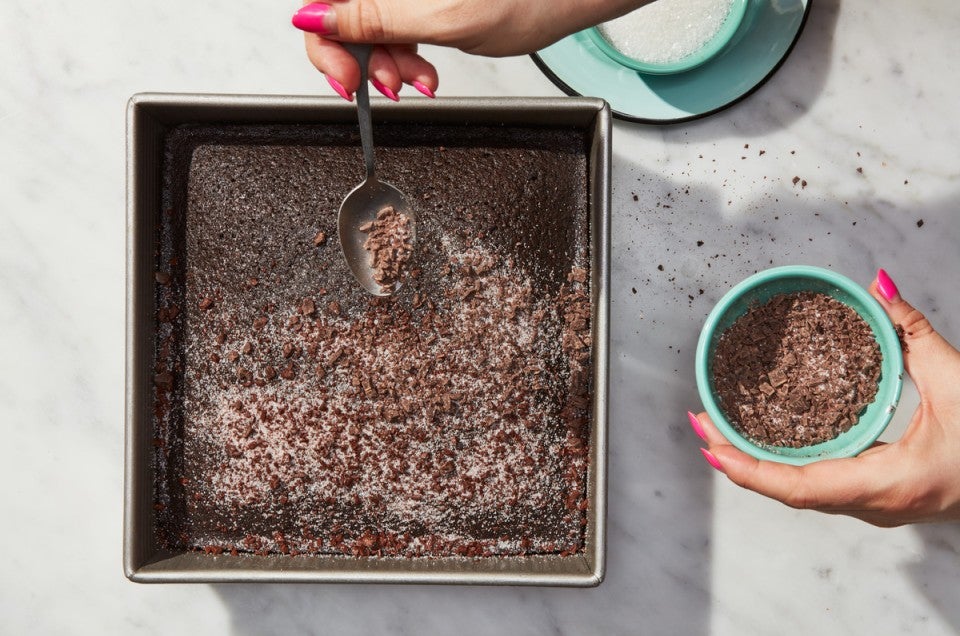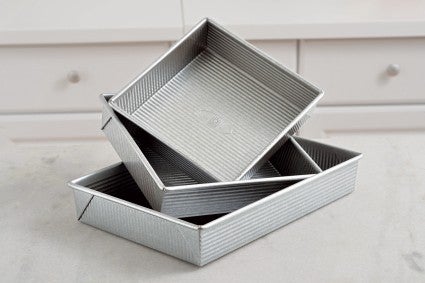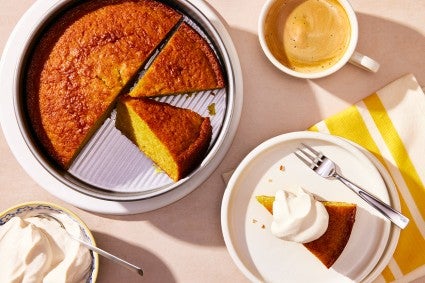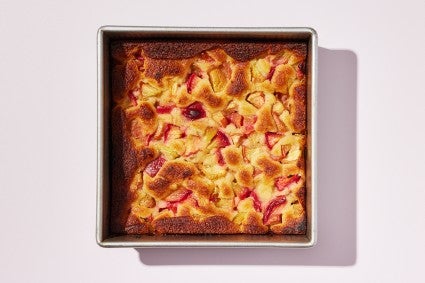Why the size of your baking pan matters so much
Plus how to adjust for different pan sizes.


Every baker eventually confronts a recipe that calls for a pan they don’t own. Substituting a different pan might be fine — or it could wreak havoc, particularly when it comes to baking cake. As a pastry chef, I wish I could tell you there was one scientific formula for converting every recipe to a different pan size. Alas, I firmly believe it’s as much an art as a science, and depends just as much on the cake itself as the pan.
When recipe developers call for a specific pan, they’ve typically thought about the final height and texture of the bake and chosen a pan that conforms to that vision. That said, I can offer a few tips for switching pans out for one you actually own. First, though, it’s important to understand the basics of pan sizes and how they affect your bakes.

Before you go swapping one pan for another, it’s essential to calculate the volume of both the pan size specified in the recipe and, if making a swap, the pan size you’re hoping to use. That will allow you to properly scale recipes up or down for various pans. An 8" square pan and a 9" round pan (both 2 inches deep) hold almost the same volume — about 128 cubic inches or 8.8 cups. You should be able to swap them without issue.
But if you’re looking to make other pan swaps, you’re going to need to do some math. Not to worry, there are plenty of online calculators available to do this math for you, so you can calculate the volume of various pan sizes and compare from there. You can also calculate the volume of an oval, so you can finally bake with that gorgeous ceramic casserole dish gathering dust in your pantry.
A note on pan material: Keep in mind that ceramic and glass conduct heat more slowly than metal, leading to less browning. Light-colored metals, like aluminum, promote a more even bake, while darker metal baking pans cause the most coloration, sometimes leading to too-dark edges.

A common mistake is confusing diameter with volume when comparing different pans. The diameter of a 9" circle is only 12.5% larger than an 8" circle, so it might stand to reason that you could bake a cake designed for a 9" round pan in an 8" round pan. But cake pans are three dimensional, not two: a 9" round cake pan actually has 26.6% more volume than an 8" round cake pan.
That means baking a 9" cake recipe in an 8" pan puts you at risk of overflowing; even if your cake doesn't overflow, more batter in a smaller pan means your cake will take longer to bake. Moreover, it takes longer for the heat of the oven to reach the center of the cake, which can cause a dry, overbaked crumb or a slumped middle. Butter-based bakes are especially prone to drying out when overbaked.
As I noted above, pans are three dimensional, so the height of a pan matters too. Springform pans are generally taller than conventional cake pans by a half to a full inch. Taller pans naturally accommodate higher volumes of batter, but they can also prevent the top of a cake from taking on too much color. I’ve noticed this anecdotally in my own kitchen, and have read that the longer sides can shield the surface of the cake from taking on too much heat as it bakes.
Pro bakers often favor 3"-tall cake pans for exactly this reason. Baking a recipe that is designed for a 9" x 3" springform pan in a 9" x 2" conventional cake pan means trading a pan with about a 13-cup capacity for one with an 8.8-cup capacity, which makes a big difference. You can expect considerably more color on the top of your bake if you make this switch — and still risk overflow as well.

So the volume of a pan is important ... but recipes rarely tell us the volume of cake batter that they produce. Here it’s helpful to look for context clues. If there’s a picture with the recipe, does it show a slim torte or a tall, sturdy coffee cake? You’ll have more flexibility with the former than the latter, as a smaller amount of batter makes adapting to another pan much easier.
It’s also important to remember not to fill cake pans up all the way to the top. For most creamed butter and one-bowl oil-based cakes, you should fill the pan between half and two-thirds full to allow the batter to expand while baking. If your cake pan looks suspiciously full, scoop some of that batter out and bake it separately in ramekins or a muffin tin (a little treat just for you!).
Keep in mind, too, that chiffon cakes, angel food cakes, and sponges require the most height to rise properly, and often work best in a pan that is designed to be flipped upside down while cooling, so they aren’t good candidates for a pan swap.
If you’re baking a cake recipe in a smaller pan than is called for, take care not to fill the pan more than two-thirds full, and keep an eye on your bake time, which may be 10 to 15 minutes longer. You may also notice more prominent doming, which can always be trimmed off if you’re assembling a layer cake.
If you’re baking a cake recipe in a larger pan than is called for, you’ll have a slimmer overall cake, and it will often bake more quickly. Begin to check on your cake about 10 to 15 minutes before the suggested bake time. This will work well for pans that are only an inch or so off from the suggested pan in the recipe. Any larger, and you’ll likely want to scale the recipe up to accommodate the larger pan.

Loaf pans can be especially tricky. The “standard” size is 8 1/2" × 4 1/2" — the so-called one-pound loaf pan, often used for bread loaves. But many cake recipes call for a 9" × 5" loaf pan. That extra half inch may seem minor, but it adds nearly a cup of volume — almost 20% more!
We usually use loaf pans for pound and tea cakes, which often need over an hour in the oven; adding more bake time if you’re using a smaller pan can turn a tender pound cake into a doorstop. That’s why, when it comes to dense, butter-based loaves, it’s always better to scale the recipe down by at least 20% for a smaller loaf pan. For tips on how to scale a recipe down, check out this blog post: How to reduce a recipe.
Personally, if the recipe calls for three eggs, I’ll scale down the recipe by one-third for convenience’s sake (who wants to use only part of an egg?). I’ll have a shorter overall loaf, but I know it will be more tender, and evenly baked, than the alternative.

Cover photo by Rick Holbrook; food styling by Kaitlin Wayne.

